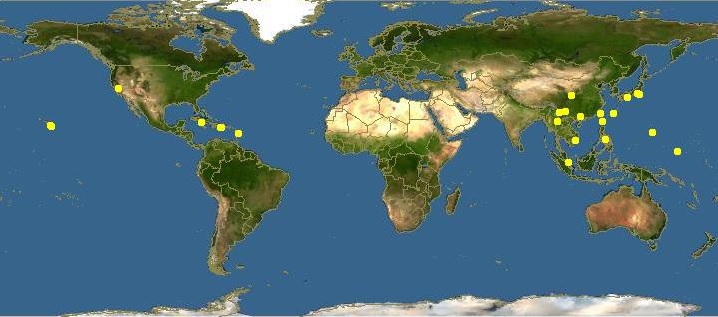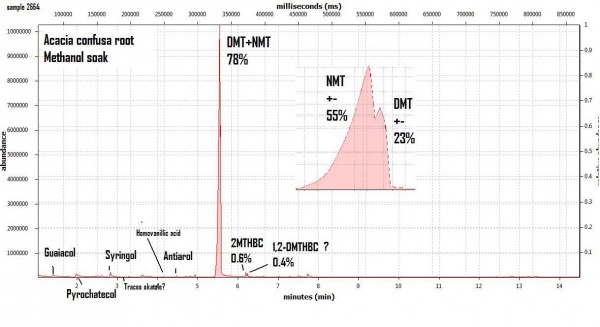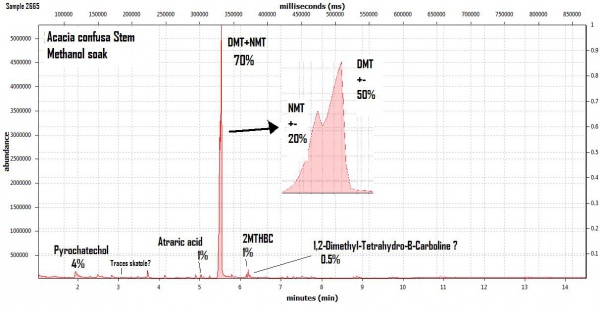Acacia confusa
| Acacia confusa |
|
|---|---|
|
Contents
General Plant Info
Acacia confusa is a perennial tree native to South-East Asia and containing high concentrations of psychoactive tryptamines in its root bark. It appears attractive for use in ayahuasca analogs[1], though at this point, experience with such preparations remains limited. Some local names include Acacia Petit Feuille, Small Philippine Acacia, Formosa Acacia (Taiwan Acacia) and Formosan Koa. The tree has become very common in many tropical Pacific areas, including Hawaii, where the species is considered invasive.[2]
Geographic distribution
Identification
Alkaloid content
Root bark
- N-methyltryptamine, 1.43%[3]
- N-methyltryptamine, N,N-dimethyltryptamine, 1.15% (Liu et al 1977 ref. Trout's Notes)
Stems
- N-methyltryptamine, 0.04%[3]
- N,N-dimethyltryptamine, 0.01% (Arthur et al 1967 ref. Trout's notes) The above references may have methodology problems as higher stem % reported more recently.[4]
- N,N-dimethyltryptamine 0.4823%,N-methyltryptamine 2.3%, DMT N-Oxide 0.01%, Bufotenine 0.003%, 2-MTHBC 0.006 [5]
- DMT, NMT, 2-MTHBC [6]
Phyllodes
One published report [Loo & Lamberton 1967] of no alkaloids in the phyllodes (leaf-like structures) has had it's validity questioned due to methodology. Other anecdotal reports of active phyllodes containing alkaloids. [7]
Seeds
- Neurolathryogen, i.e. α-amino-β-oxalylaminopropionic acid, which can cause neurological damage, paralysis and death.[3]
The seeds are considered poisonous and reported to cause headache upon ingestion. [8]
Little research has been done, but successful ayahuasca preparations[9][10] and direct oral activity[11][12] using the root bark (and possibly, ordinary bark) have been reported.
Ayahuasca analogs prepared with Acacia confusa root bark are known as Formosahuasca (after Formosa acacia, i.e., the beautiful acacia, presumably after Ilha Formosa, i.e., the beautiful island, the original Portuguese name for Taiwan), or alternatively as Chinahuasca or Asian Ayahuasca.
The psychoactive tryptamines extracted from Acacia confusa are described in a number of publications. [13]
Other uses
The plant is considered medicinal in Taiwan.[14] (The same publication reports it as toxic, without providing further details.)
Online excerpts from Chinese medicine books (precise references are not given) state that the root can be used for detoxification, treating larynx and windpipe inflammation and liver disorders. (Original Chinese text: 根有清热解毒、解暑发表的功能。可用于治疗咽喉肿痛,黄疸性肝炎及慢性气管炎等。)
Positive outcome has been reported for applications of Acacia confusa bark extract to combat the liver toxicity of carbon tetrachloride in rats. [15] Goat foraging on the plant has been observed. [16]
Extraction
Cultivation
Links
- Acacia confusa on Wikipedia
- Photographs of the different parts of the plant
- Erowid Acacia vault
- Reality Sandwich
References
- ↑ Seemingly promising Acacia species lacking bioassay reports in Ayahuasca: alkaloids, plants & analogs by Keeper of the Trout
- ↑ Pacific Island Ecosystems at Risk (PIER)
- ↑ 3.0 3.1 3.2 Lycaeum
- ↑ Trying to improve Acacia information - DMT Nexus
- ↑ Acacia Analysis - DMT Nexus
- ↑ Acacia Analysis - DMT Nexus
- ↑ Trying to improve Acacia information - DMT Nexus
- ↑ edu.ocac.gov.tw
- ↑ Erowid Report
- ↑ A Guide to Brewing Asian Ayahuasca
- ↑ Erowid Report
- ↑ Acacia confusa and Formosahuasca - DMT-Nexus
- ↑ Arthur, H.R., Loo, S.N. & Lamberton, J.A. Nb-methylated tryptamines and other constituents of Acacia confusa Merr. of Hong Kong. Aust. J Chem. 20 (1967) 811 online text; Lee, T.H. and Chou, C.H. Flavonoid aglycones and indole alkaloids from the roots of Acacia confusa, Journal of the Chinese Chemical Society 47 (2000) 1287-1290, online text; Buchanan MS, Carroll AR, Pass D, Quinn RJ. NMR spectral assignments of a new chlorotryptamine alkaloid and its analogues from Acacia confusa, Magn Reson Chem. 2007 Apr; 45(4):359-61, online text
- ↑ Li, Thomas S. C. Taiwanese Native Medicinal Plants: Phytopharmacology and Therapeutic Values, CRC Press (2006), ISBN: 0849392497, p.2. online GoogleBooks preview full text
- ↑ Tung, Y.-T., Wu, J.-H., Huang, C.-C., Peng, H.-C., Chen, Y.-L., Yang, S.-C., Chang, S. T. Protective effect of Acacia confusa bark extract and its active compound gallic acid against carbon tetrachloride-induced chronic liver injury in rats, Food and Chemical Toxicology 47 (2009) 1385–1392, online text
- ↑ K. Hagstrom, M. L. Christiansen and E. R. Cleveland. Plants in Hawaii that are eaten by goats, J. Haw. Pac. Agri. 4 (1993) 101-105, online text



